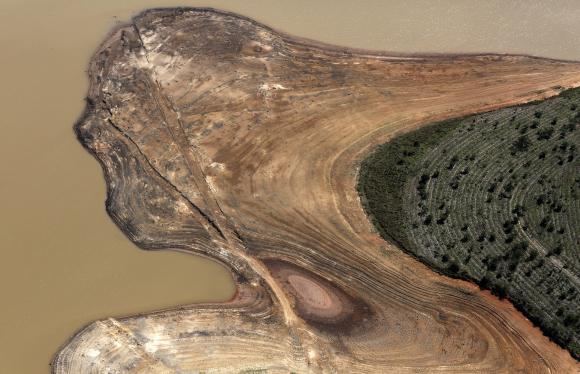Brazil water supply, crops still at risk a year after epic drought
Date: 12-Jan-15
Country: Brazil
Author: Caroline Stauffer

n aerial view of the Atibainha dam, part of the Cantareira
reservoir, during a drought in Nazare Paulista, Sao Paulo state,
Brazil
Photo: Nacho Doce
Southeastern Brazil is getting some rainfall a year after a record drought started, but not enough to eliminate worries about electricity rationing, drinking-water shortages or another season of damaged export crops, meteorologists said.
Record-high temperatures and the most severe drought in at least 80 years punished southeastern Brazil last year, a region accounting for 60 percent of the country's gross domestic product. Lingering climate challenges could threaten a tepid economic recovery.
Private weather forecaster Somar warned of irregular rainfall in the center-west soy belt as well as the southeast throughout the month as an atmospheric blockage prevents a cold front from advancing over the key producing regions in the world's largest exporter of coffee, sugar, soy and beef.
That is especially worrisome in the southeastern state of Minas
Gerais, which produces half of Brazil's coffee. Drought there last
year wiped out as much as a third of the crop in some areas, causing
global arabica prices to rise 50 percent over the year even as most
other commodity markets tumbled.
Scientists said coffee trees would not recover from the extreme heat and drought quickly, and forecasts pointing to below-average rain in January caused arabica prices to rise 12 percent this week.
Somar agro meteorologist Marco Antonio dos Santos expressed concern about the 2015 coffee crop, which will be harvested between May and August.
"It's not like 2014, when the whole crop was affected, but I am sure there will be regional damage," he said. "Some red flags are going up."
The Reuters weather dashboard on Friday showed that by Jan. 23, rainfall would be about half the historical average in the southeast region and 300 mm (11.8 inches) below average in Minas Gerais.
POTENTIAL WATER SHORTAGE
Rains are not likely to bring reservoirs back to comfortable levels in southeastern Brazil, which is responsible for 70 percent of the country's hydroelectric generation. Brazil, which has the world's largest fresh water supply, usually relies on hydro-power to generate more than two-thirds of its electricity.
The national grid operator slashed its forecasts for January rain over reservoirs in the southeast and center-west regions on Friday to just 56 percent of the historical average from 82 percent a week earlier.
It said reservoirs would probably end January between 19.2 percent and 25.3 percent full. That is about half of the 41 percent a year ago and well short of the 60 percent level specialists consider ideal ahead of the dry season.
Even so, the government has ruled out electricity rationing as power distributors turn to expensive alternatives like thermal. The president of the CCEE spot-market electricity clearinghouse said last month that he expected thermal plants in the southeast to remain active for two more years.
Rising energy prices have increased costs for electrical distributors and the government is considering a nearly $1 billion loan from state-run banks to help companies cover costs. It would be the third such loan in less than a year.
Climatempo meteorologist Alexandre Nascimento said potable water shortages in 2015 are possible for the 20 million people of Sao Paulo, South America's largest city,
"In the best hypothesis," he said, "we will be able to recover the dead volumes," which are the muddy reserves at the bottom of the city's main reservoir that state-run utility Sabesp has relied on for months to keep taps running.
Sabesp received authorization this week to implement steep fines for above-average water use, but some fear the measure came too late. The Cantareira reservoir was at 6.7 percent capacity on Friday, even after several afternoons of violent summer rainstorms in Sao Paulo.
(Writing by Caroline Stauffer; Editing by Todd Benson, Lisa Von Ahn and Marguerita Choy)
![]()
© Thomson Reuters 2014 All rights reserved